Lot's daughters
The daughters of the biblical patriarch Lot appear in chapter 19 of the Book of Genesis, in two connected stories. In the first, Lot offers his daughters to a Sodomite mob; in the second, his daughters have sex with Lot without his knowledge to bear him children.
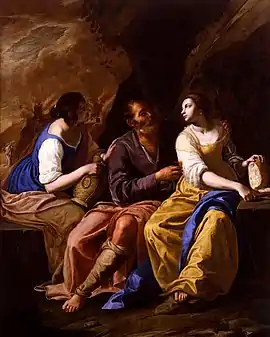
Only two daughters are explicitly mentioned in Genesis, both unnamed. However, the Hebrew midrash (interpretation) The Book of Jasher describes another daughter by the name of Paltith, who is burned to death by the Sodomites for breaking their law against giving charity to foreigners.[1]
The story of Lot offering his daughters to the Sodomites is also found in surahs 11 and 15 of the Quran, although there is no mention of the rape of Lot.
In the Book of Genesis
In Genesis 19, Lot shows hospitality to two angels appearing as men who arrive in Sodom, and invites them to stay the night at his house. However, the men of the city gather around the house and demand that Lot hand over the men so they can "know them". Lot admonishes them for their wickedness, and offers the mob his two virgin daughters instead. When the mob refuses Lot's offer, the angels strike them with blindness, and then warn Lot to leave the city before it is destroyed.[2]
Verse 14 states that Lot has sons-in-law, "which married his daughters".[3] This seems to contradict the earlier statement that his daughters were virgins. According to the NIV translation, these men were only "pledged to marry" his daughters. Robert Alter suggests that the reference in verse 15 to "your two daughters who remain with you" indicates that Lot's two virgin daughters left the city with him, but that he had other, married daughters who stayed behind with the sons-in-law.[4]
The King James Version (KJV) and the New Revised Standard Version (NRSV) describe the older surviving daughter as "the firstborn", while the Contemporary English Version (CEV) uses "the older".[5]
During the escape from Sodom, Lot's wife turns into a pillar of salt. Lot and his daughters take shelter in Zoar, but afterwards go up into the mountains to live in a cave. Concerned for their father having descendants, one evening, Lot's eldest daughter gets Lot drunk and has sex with him without his knowledge. The following night, the younger daughter does the same. They both become pregnant; the older daughter gives birth to Moab, while the younger daughter gives birth to Ammon.[6]
According to Jewish tradition, Lot's daughters believed that the entire world had been destroyed, and that they were the only survivors. They therefore resorted to incest in order to preserve the human race.[7] This was also the general opinion of the Early Church Fathers, such as Augustine,[8] Chrysostom[9] and Irenaeus.[10] The basis of this idea is the comment of the elder daughter that "there is not a man in the earth" to give them children.[11] However, commentators such as John Calvin have pointed out that the family had only recently dwelt in Zoar, so they must have known they were not the only people left alive. Calvin therefore concludes that the elder daughter's remark refers not to the whole earth, but only to the region in which they were living.[12]
Many scholars have drawn a connection between the two episodes of Lot's daughters. According to Robert Alter, this final episode "suggests measure-for-measure justice meted out for his rash offer."[13]
A number of commentators describe the actions of Lot's daughters as rape. According to Esther Fuchs, the text presents Lot's daughters as the "initiators and perpetrators of the incestuous 'rape'".[14] Alter agrees, adding that when the elder daughter says "let us lie with him", the meaning of the Hebrew verb in this context "seems close to 'rape'".[15] It is also one of three accounts of "sperm stealing" in the Bible, in which a woman seduces a male relative under false pretenses in order to become pregnant.[16]
According to a footnote in the New English Bible this is an unflattering origin story of the Ammonites and the Moabites, the two traditional enemies of Israel.
In the Quran
The story of Lot offering his daughters to the Sodomites is also found in surahs 11 and 15 of the Quran.[17] Islamic commentators generally interpret these passages to mean that Lot offered his daughters in lawful marriage.[18] The Sodomites' refusal of the offer is explained in various ways, such as that Lot insisted that anyone who married his daughters must first convert to his religion; or that the Sodomites had been refused permission to marry his daughters in the past, and therefore had no legal right to them now.[19]
A variation on the marriage theory holds that the phrase "my daughters" should be taken in a metaphorical sense. Lot, as a prophet, is considered a father to his people; he is therefore inviting the Sodomites to intermarry with the women of his nation.[20]
The story of Lot's incestuous relationship with his daughters is not alluded to in the Quran.[21]
In art
Lot's sexual relationship with his daughters was a theme seldom explored in medieval art.[22][23] In the sixteenth century, however, the story became popular with European artists, primarily due to its erotic potential. Depictions of Lot and his daughters in this era were generally charged with sexuality; the daughters would often be painted as nudes, and Lot would be portrayed (in contradiction to the Bible narrative) as "either a happily compliant figure or an aggressive seducer".[24]
Gallery
.jpg.webp) Jan Wellens de Cock, 1523
Jan Wellens de Cock, 1523.jpg.webp) Lucas Cranach the Elder, 1528
Lucas Cranach the Elder, 1528 Lucas van Leyden, 1530
Lucas van Leyden, 1530.jpg.webp) Bonifazio Veronese, 1545
Bonifazio Veronese, 1545 Joachim Wtewael, c. 1600
Joachim Wtewael, c. 1600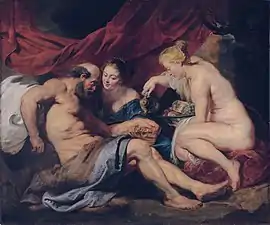 Peter Paul Rubens, c. 1613-14
Peter Paul Rubens, c. 1613-14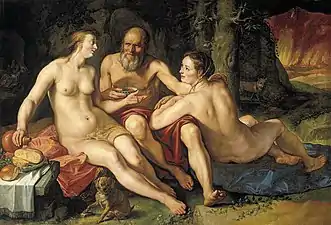 Hendrick Goltzius, 1616
Hendrick Goltzius, 1616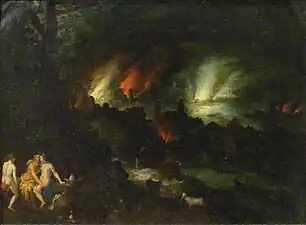 Jan Brueghel the Elder, 17th century
Jan Brueghel the Elder, 17th century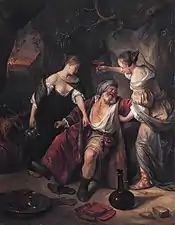 Jan Steen, c. 1665-7
Jan Steen, c. 1665-7
See also
- Monastery of St Lot, Byzantine monastery at what was thought to have been the "cave of Lot"
- Sperm theft
References
Citations
- Noah 1840, p. 51, Ch. XIX.
- Gen 19:1–13
- Gen 19:14
- Alter 2008, p. 93.
- Compare KJV, Gen 19:31 33, 34, 37 and NRSV, Gen 19:31, 33, 34, 37, with CEV, Gen 19:31, 33, 34, 37.
- Genesis 19:30–38
- Kadari 2015.
- Augustine.
- Hill 1990, p. 464.
- Irenaeus.
- Gen 19:31
- Calvin.
- Alter 2008, p. 92.
- Fuchs 2003, p. 209.
- Alter 2008, p. 96.
- Yaron, Shlomith. "Sperm stealing: a moral crime by three of David's ancestresses". Bible Review 17:1, February 2001
- Quran 11:78; 15:71
- Ahmed 2011, p. 422: "The marriage hypothesis is, by far, the most popular interpretation of Lot’s offer among Muslim exegetes"
- Ahmed 2011, p. 420.
- Ahmed 2011, p. 421.
- Jamal 2001, p. 19.
- Lowenthal 1988, p. 14.
- Mellinkoff 1998, p. 832.
- Mellinkoff 1998, p. 834.
Sources
- Ahmed, Waleed (2011). "Lot's daughters in the Qu'ran". In Reynolds, Gabriel S. (ed.). New Perspectives on the Qu'ran. Routledge. ISBN 9781136700781.
- Alter, Robert (2008). The Five Books of Moses: A Translation with Commentary. New York: W. W. Norton. ISBN 978-0-393-07024-8.
- Augustine. "Contra Faustum (Book 22, Section 43)". New Advent. Retrieved 23 May 2021.
- Calvin, John. "Genesis 19". Commentary on Genesis, Vol. 1. Christian Classics Ethereal Library. Retrieved 30 March 2021.
- Fuchs, Esther (2003). Sexual Politics in the Biblical Narrative: Reading the Hebrew Bible as a Woman. A&C Black. ISBN 978-0-567-04287-3.
- Hill, Robert C. (1990). "Homily 44". Saint John Chrysostom: Homilies on Genesis 18-45. The Catholic University of America Press. ISBN 9780813200743.
- Irenaeus. "Against Heresies (Book IV, Chapter 31)". New Advent. Retrieved 30 March 2021.
- Jamal, Amreen (2001). "The Story of Lot and the Qur'an's Perception of the Morality of Same-Sex Sexuality". Journal of Homosexuality. 41 (1): 1–88. doi:10.1300/J082v41n01_01. PMID 11453512. S2CID 9184418.
- Kadari, Tamar (24 October 2015). "Lot's Daughters: Midrash and Aggadah". Jewish Women's Archive. Retrieved 2018-12-06.
- Lowenthal, Anne W. (1988). "Lot and His Daughters as Moral Dilemma". In Fleischer, R.E.; Scott, S.C.; Munshower, S.S. (eds.). The Age of Rembrandt. Pennsylvania State University. ISBN 9780915773022.
- Mellinkoff, Ruth (1998). "Titian's Pastoral Scene: A Unique Rendition of Lot and His Daughters". Renaissance Quarterly. Cambridge University Press. 51 (3): 828–63. doi:10.2307/2901747. JSTOR 2901747. S2CID 194086764.
- Noah, Mordecai Manuel, ed. (1840). Sefer Ha-yashar, Or, The Book of Jasher. New York: M.M. Noah & A.S. Gould. ISBN 9780790517254.
- Sabo, Peter J. (September 2020). Shepherd, David; Tiemeyer, Lena-Sofia (eds.). "Moabite women, Transjordanian women, and incest and exogamy: The gendered dimensions of boundaries in the Hebrew Bible". Journal for the Study of the Old Testament. SAGE Publications. 45 (1): 93–110. doi:10.1177/0309089219862807. ISSN 1476-6728. S2CID 221626733.